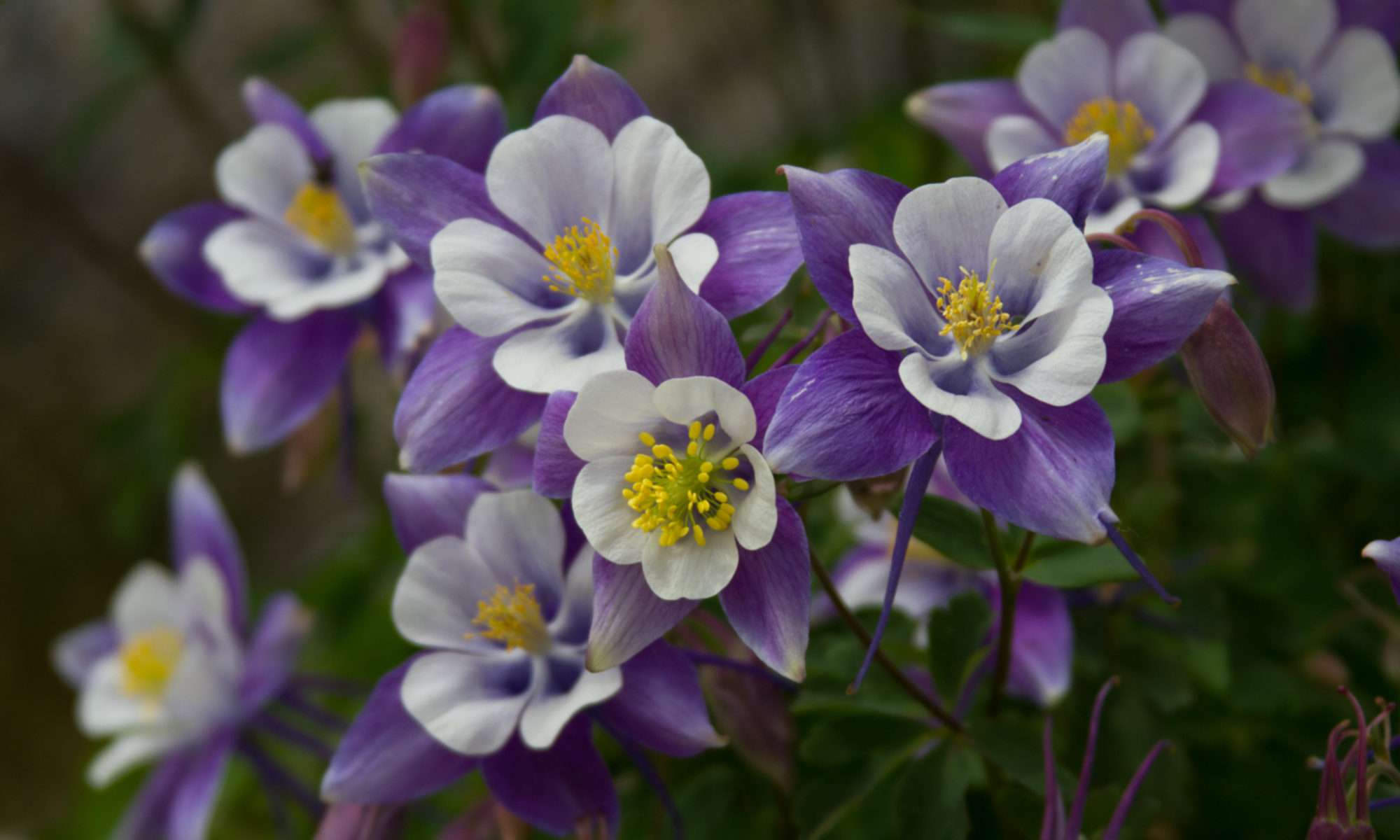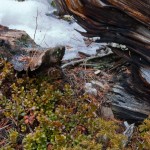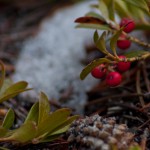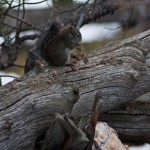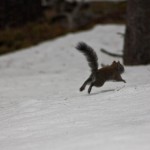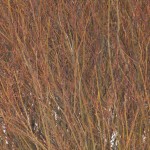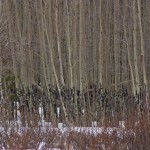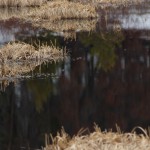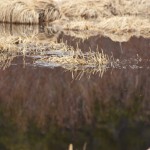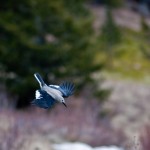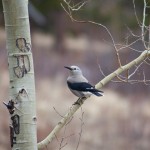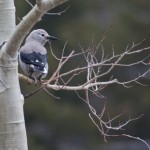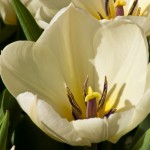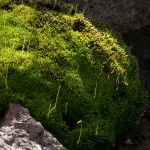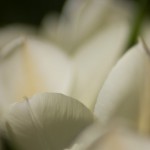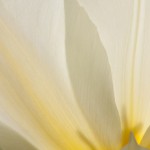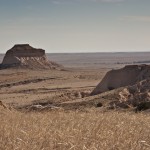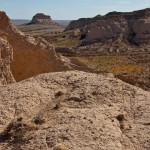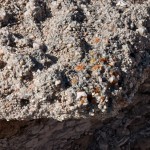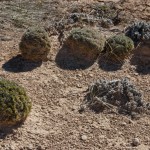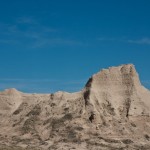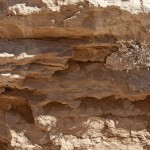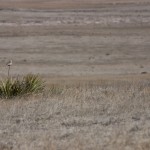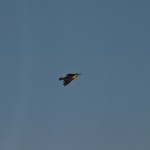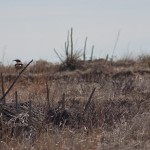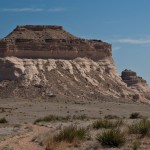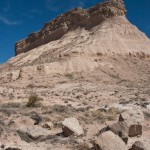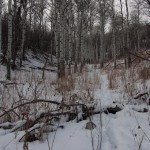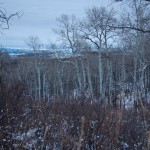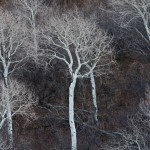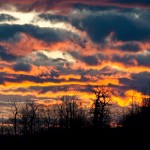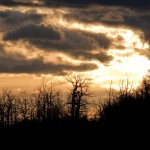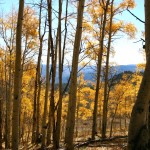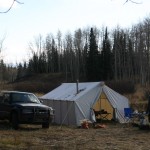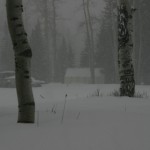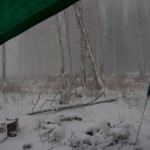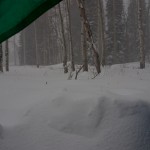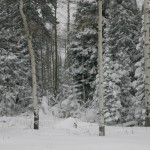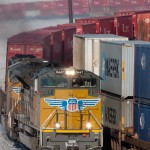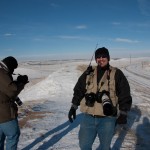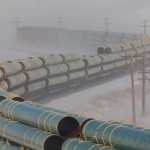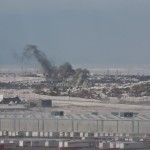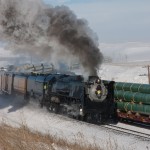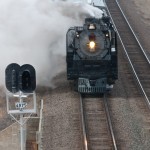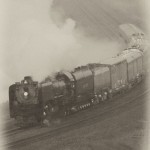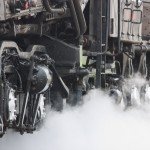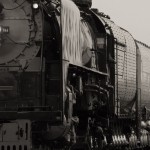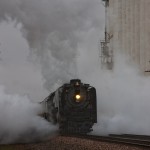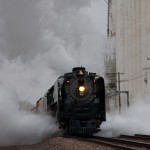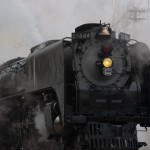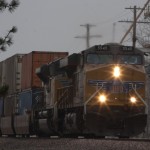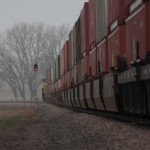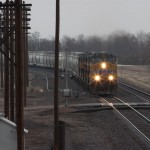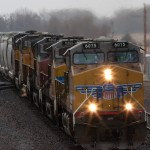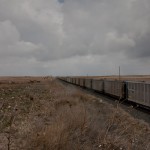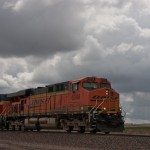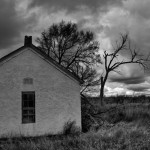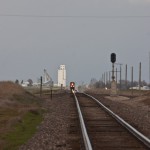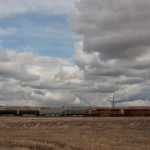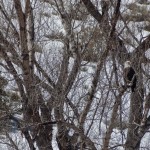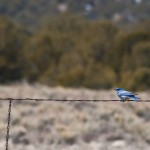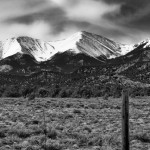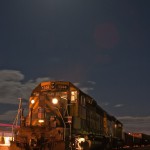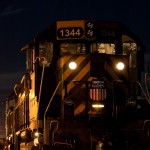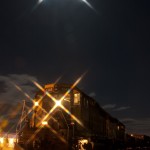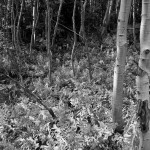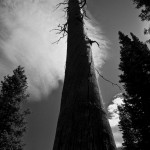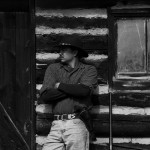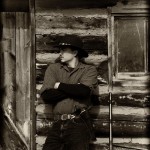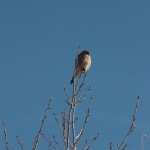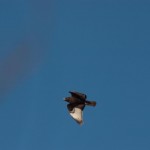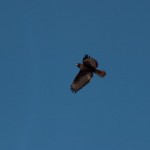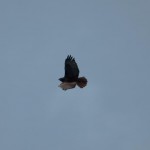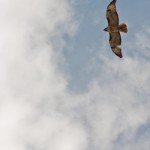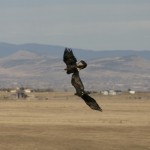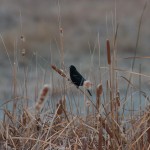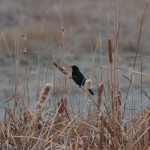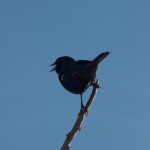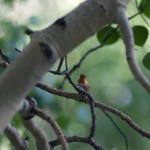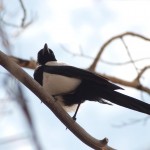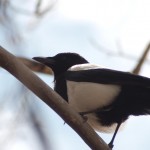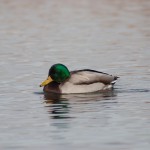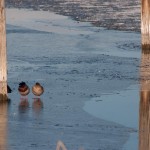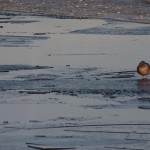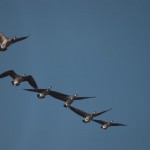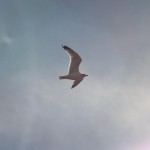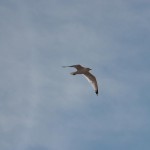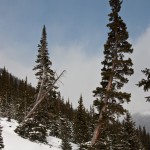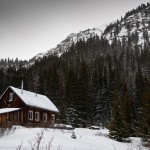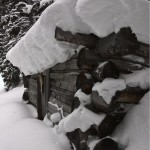So my cousin B. Petro and I have been meaning to go out for one of those lengthy photographer hikes for some time now, and finally last Friday we made it happen. When she asked me “where should we go,” I said “Rocky Mountain National Park at sunrise!” Now watching the weather reports leading up to that day, I began to get a sinking feeling that there would be no sunrise (at least one we could see) on Friday morning. I won’t go into how most of the time weather people can’t predict the weather, especially spring weather in the Rockies, but this time they were right. We awoke at 4:00 am to partly cloudy skies that were only partly cloudy to give us a tiny glimmer of hope that the sun might shine long enough to get some of that great morning light that landscape photographers chase. As the sky lightened from dark grey to light grey, we decided not to enter RMNP, and instead stop short of entering the park. We instead made a brief stop to shoot the St. Malo Chapel on the rock in the gathering light. Unfortunately for us, Mount Meeker, the usual backdrop for the chapel, was shrouded in the low clouds. On the other hand, it made for some spectacularly moody light on the stone church. From there, we headed toward the Long’s Peak trailhead that can be accessed from near Allenspark. While Long’s is contained withing Rocky Mountain National Park, this trailhead can be accessed without entering the park itself. We took a short 1.4 mile hike to the Eugenia Mine through the somewhat hard packed snow. If you have never taken a trail hike in April in the Rockies, let me tell you that it is more work than you think. Snowshoes aren’t required if you stick to the packed trails made through the winter, but the possibility of slipping off to one side of the track and into thigh deep snow is very high, making for a bit of work, and wet socks. The Eugenia mine itself wasn’t much to speak of, making for quite an anti-climactic end to the hike. However, the low clouds made us turn our camera lenses down to the forest floor for some nice macro shots in the even light. On the return hike, we were visited by a very curious Grey Jay, also known around here as a Camp Robber, due to their tendency to snatch unattended food and flit away without a sound. We also caught a couple Grey Squirrels munching on pine cones recently uncovered by the receding snow. Back at the trailhead, we thought we would drive a bit down the road to see if there was anything of interest at Lily Lake. Just off state highway 7 between Allenspark and Estes Park, Lily Lake offers a short walk on a graded path around the lake itself, and great views of Long’s Peak (when not overcast). We were less than thrilled at the flat lighting and lack of mountain views, but we did our best with what we had to work with. Until we reached the north side of the lake, and found the forest awakened with bird life! I counted seven species of birds that we could see just standing on the path; American Robins, Mountain Chickadees, Mountain Bluebirds, Northern Flickers, Clark’s Nutcrackers, and Ravens. Too bad only one of us brought a telephoto lens, and it happened to be mine, who’s only favorable attribute is its ability to shoot closeup macro! But again we chose to make lemonade from apples, and traded said lens back and forth between us (good thing we both shoot Canon SLRs) and got a few good clicks of the Clark’s Nutcrackers flying to and fro. It was good to spend time with my cousin again, since life gets in the way of what we want to do so often. Here’s the results from the our morning out:
Zoom Zoom
Sometimes you don’t have to go far for photographic inspiration. I was drinking coffee on my patio this morning watching the Tulips bloom, and thought “damn those are pretty.” Took me a while before I actually went upstairs to get the camera though, and I also did something that I hadn’t done in a loooong time; I shot film of them too! Some of you may say “what the hell is film?” I have no idea who processes film these days for somewhat of a reasonable price, but I did it anyway. It was kinda fun getting back to where it all started with me, using my Dad’s Pentax K1000 which is manual everything; manual shutter speed, manual aperture, manual frame advance. Luckily, it has a built in light meter, so I didn’t have to go completely old school. But it made me slow down on the composition and make sure all the settings were correct before I clicked. Also made me appreciate my outdated Canon digital SLR quite a bit. For those uninitiated, macro photography refers to super closeups, and one of the most common subjects of macro photography are flowers. I have shot many macros of flowers, mosses, lichens and is one of my favorite types of photography. So here are the digital results, unfortunately I will not be able to post the film results here…
Pawnee Buttes
I seem to be obsessed with places named “Pawnee…” Unlike the pass that bears the same name, the Pawnee Buttes are out on the plains of northern Colorado contained within the Pawnee National Grassland. Now just let me say that I am more accustomed to the mountains and photographing the landscapes there, so coming out to a “National Grassland” is something new for me, as well, I had to adapt my photography to suit. I tried to incorporate the ENORMOUS sky in many of the shots to try to encompass the immense feeling of openness that the plains offer.
For wildlife, I didn’t see very much while there. Eagles, hawks and falcons nest on the escarpment to the south of the west butte, but none were in the air, and the area was closed to foot traffic. The meadow larks were quite busy singing and flitting about though, and got a couple clicks on them when they would allow it. My need for a longer reaching lens was made evident, since I could not get within about 60 or 70 yards of any of them.
As far as geology goes (those of you that bore easily might as well go on to the photos), the buttes themselves are made up of soft clays and shale of the Brule Formation, somewhat protected from erosion by the harder sandstone and conglomerate of the Arikaree Formation. Conglomerates and sandstone differ in consistency only by the size of the sediments they contain. Conglomerates tend to have the look and feel of a rough concrete, holding small rounded pebbles and cobbles ranging in size from 1/16th of an inch up to 3 inches in diameter. Sandstones are just what they sound like; sand and clay compacted and hardened (process called lithification), ancient sediments that were laid down when the whole area was an inland ocean. Fossils are commonly found in the clay and shale underlying these harder materials. Miocene and Oligocene fossils of horses, camels, birds and tapirs have been found in the area.
I enjoyed the trip, I hope you do too!
Hunting on my mind
For big game hunters in Colorado, it’s the time of year when we enter our applications for the coming year’s hunt. This for me is always agonizing, thinking so hard about where to go and getting psyched up in April, when the seasons won’t start for another 5 months! Previous years have all passed in the same manner, and the seemingly never-ending wait through the summer until fall finally approaches once more, summer’s sticky heat gives way to cool dry smell of autumn approaching, the smell of dry grasses, and sleepy trees readying themselves for a long Colorado winter. There is something about it that sings to my soul, a connection with the ancient tradition that is the hunt. It’s difficult to explain, unless you have been there. I often find it easier to express myself better through writing than through speech, it gives me time to plan what I am going to say, how to say it, and keep it all coherent. These days living such a closed off sterile plastic world, we tend to cut ourselves off from anything that requires us to get our hands dirty. I have heard camping described as “pretending to be homeless”, and hunting as “barbaric”, but I believe both to be so much more. This is where my website gets its name, I am always hunting, whether with the camera or rifle, hunting for that special feeling I get when out in the wilderness.
From a spiritual perspective (for me at least), camping and hunting strip away the distractions of modern life, and in this simplicity, we are more prone to feel natural world rather than just see it. The Buddhist monks know this best, living with the barest of necessity brings one spiritual insight. Out there during the hunt, your senses are tuned, you focus on your surroundings with them; seeing movement, hearing a rustling of grass or a breaking of a twig, feeling the breeze and the ground under your feet, the smell of life in the trees, even tasting it on the air, and that elusive sixth sense of feeling the energy surrounding you, bringing back the animal instincts that are inside all of us. Or more simply, communing with nature. This is my church; feeling embraced and surrounded by all these things gives me comfort and happiness, more so than can be described here. Gralloch is old Scots term meaning to remove the offal from an animal. Long before Christianity reached the Isles, it became custom to say a quick prayer of thanksgiving when butchering an animal, either wild or homegrown. This became known as the Gralloch prayer, and was an intensly personal moment for the hunter, and a great many cultures hold a similar ritual; for American Indians, the heart is the seat of the soul, and is buried or burned to allow the spirit of the animal to escape its earthly body. In Germany, this is a time meant to contemplate the complex mixture of elation and sadness that comes with killing any animal. A downed deer is laid on its right side, with a small branch of fir or oak—known as Der letzte Biss (“the last bite”)—placed in its mouth as a mark of respect. A second branch is placed on the deer to show that the hunter has assumed ownership of the dead animal. Hunters who follow all the appropriate rules and traditions of the hunt are presented with a shooter’s branch, which is worn in the left side of the hatband until sunset on the day of the kill. I could fill a book with examples of customs such as these that dispel the notion that hunters are a bunch of bloodthirsty barbarians.
From a pragmatic stand point however, hunting is more than just going out “to shoot something.” Conservation is the name of the game when it comes down to it. The Colorado Division of Wildlife receives no state tax revenue. All hunting and fishing license fees are deposited in a game cash fund, but the state Legislature has final authority over Division spending. The CDOW brings in more money in one year than the ski resorts combined, not alone indirect boost to the state’s economy, an estimated boost of 3 billion dollars annually. The late 1890’s were a time of careless slaughter, when commercial hunting was actually the business of killing, and the massive expansion of cattle ranches, and the fencing off the frontier caused the near extinction of the buffalo. Most of the natural predators of these animals were killed as well, throwing the natural cycle out of balance. Later, when early hunting regulations were in place, another problem made it’s appearance, one that can be seen today in Rocky Mountain National Park. The elk populations exploded to the point where the habitat could no longer support them. The animals started getting sick, and would die of starvation in the summer, not to mention the numbers that die during the harsh winter months. Since hunting is not allowed in National Parks, and no wolves exist in the park, and the mountain lion populations are controlled to protect the visitors, there are no natural predators to keep the populations in check. To me this is more cruel than a quick death of a hunter’s arrow or bullet.
So here I sit thinking hard about it once again, reminiscing in the ritual of preparation. Gathering the equipment, tent, stove, sleeping bag, cot, camp cookware, food, lantern, firewood, rifle, bullets, hunting pack, clothes, boots, knives, licenses. Then the drive and the subsequent search for the “perfect” campsite (this curse I came by as a matter of genetics). Pitching the tent and the smell of autumn mountain air and canvas, the warmth of the sun on my skin as I mentally prepare for the next frosty morn that will begin the hunt again…
Here’s some incidental clicks of the camera from the last couple years’ hunting trips.
Steam, Trains, and Plains
My friend Kevin called me and told me to clear my schedule for April 2, because Union Pacific was running it’s 844 steam locomotive on an excursion train east from Cheyenne, WY. For more info on 844 click here. Needless to say, I was excited since I hadn’t had a train of any kind in my viewfinder since last August. We started the day early at 5:30am, headed north to Cheyenne to pick out our spot among the almost certain crowd of railfans that would be out and about chasing the same train. We reached a spot east of Cheyenne, known as Archer on railroad timetables. The wind was howling at around 25mph, and the temperature was hovering around the same number, causing the wind chill to be around 12. Kevin and I decided long ago that we would rather get a couple great shots, rather than a hundred crappy ones, so we walk the 1/2 mile down along the tracks to get a better view of the S-curve that was offered, leaving the others standing near the road overpass. While we were waiting for 844 to depart, there was no shortage of other trains to shoot during our wait. There was no question as to when 844 was leaving Cheyenne, the towering plume of smoke and steam was a bit of a clue. For an old steamer, this locomotive can haul! We left Archer, and headed east. The next place we caught up with it was at Pine Bluffs, WY nearly 42 miles to the east! Next stop was in Nebraska at a spot called Point of Rocks. Now, I learned quite quickly that places were named quite literally out here on the plains. After a short walk to a nice high vantage point, we waited in the wind and sleet for a few minutes until 844 passed us once again. The schedule had 844 stopping at Lodgepole, NE too take on water and for the crew grease up the running gear. This was where we let 844 continue on its way to point east, and ultimately Haringren, TX. We then explored the area of Sidney, NE where Union Pacific and BNSF mainlines cross and interchange. We chased a couple BNSF trains both northbound and southbound before heading back south to home. I gained a new appreciation and fascination with the Great Plains and hope to make more excursions myself. The land itself holds its own kind of grandeur, as well as a plethora of railroad history. Hope you enjoy the results of the day!
Mountains, Birds, and a Canyon
Well, it’s been a week since we returned from Montrose, and I am just now getting around to posting some photos from that return trip! Since Interstate 70 had only one lane open through Glenwood Canyon, we took the “scenic” route via US285/US50 which takes you past a great variety of climes in this great state. My opinion is that you get a bit of every type of landscape Colorado has to offer along this route; plains, high mountain passes, fourteeners, high mountain parks, down to the arid semi-desert dotted with stunted pines on the western slope. Along the way we had seen mule deer, pronghorn, golden eagles, bald eagles, bluebirds, and ravens. Coming up to Cerro Summit, we paused a few minutes so I could take a couple clicks of a Bald Eagle perched in a cottonwood watching Cedar Creek for a nice fish (who can blame him?) We then stopped for lunch near the Blue Mesa Dam, and looked down at the start of the Black Canyon of the Gunnison. Next, we stopped along US285 with a great view of Mount Shavano and company to let the dog stretch her legs a bit. Afterward, we just drove straight on home, as we were both fairly exhausted by that point and wanted to get home.
Gone Loco
While my lovely wife and I were in Montrose this past weekend, I had an opportunity I couldn’t pass up. After we went out to dinner at an AMAZING restaurant, we passed the power for the Montrose local sitting ready for a Sunday morning departure, and what do my eyes see? Class lights! Class lights lit up! For those outside the railfan circle, class lights are located on the nose of a locomotive that change color with the direction of that locomotive. They have not been in use for sometime since the early 1990’s, since FRA (Federal Rail Administration) rules change quite often regarding the visibility of locomotives. So with that pontification out of the way, back to the story. The sun had long since gone down, and the moon was rising, I had my tripod with me, so I stopped for some low light photos! I was quite happy with the results, given the limited time I had to shoot.
Black and White!
I was reading a magazine recently when I came across a software product from Nik Software called Silver Efex Pro, and I couldn’t resist giving it a try. Nik produces some amazing plug-ins for Adobe Photoshop and Lightroom, but what attracted my attention to Silver Efex was my admiration of Ansel Adams (like any nature photographer) and my own experience shooting black and white film and developing it in a darkroom. As is so common with digital photography these days, the darkroom has moved to the computer. For those so called ‘purists’ that believe you are not a ‘real’ photographer if you do any kind of post-processing with your digital photos, I ask you to please give me a break. How many hours shut in a darkroom do you think Adams or any others spent dodging, burning, masking and formulating developers for both film and print? My answer is a whole lot more than it would take now with the digital darkroom. Anyway, (stepping off my soapbox) here are some of the results I have using Silver Efex. There are some amazing tools and effects that can be achieved with this tool.
Avian Conglomerate
No, it’s not a company run by birds, just a fancy way of saying “bird gallery”. I was searching through photos from the past five years, and I realized that I have more bird pictures than of any other wildlife. Why? I guess it’s because as a younger man, I wanted to be a pilot and I could feel myself flying. That dream didn’t materialize, but I never stopped watching the birds fly. Again, living close to an open space area gives me an opportunity to see more kinds of birds than one would normally see in a suburban setting. I have also made a concerted effort in recent years to identify the birds I see as well, so here is a collection of some common and not-so-common avians.
Saints John Snowshoeing
I’ve been feeling the cabin fever quite severely in recent days, so I decided to get the hell out of the house and go snowshoeing again. This time I basically opened my snowshoeing guide-book to a page, pointed to a trail and went there. The trail to Saints John is a short trip, but a grueling one. Steep and steady, it took me two and a half hours to climb 1140 feet in 2.25 miles, and half that time coming back. As soon as I started the snow began to fly, which didn’t bother me too much since I was out to be in the snow. Malie (my dog) loves the snow, and I only wish I had as much energy and stamina as she does! We reached timberline, and the wind was picking up, so we stopped so I could take a few shots of the snow-clad forest and enjoy the quiet solitude. My reverie was broken by the sound of a pair of snowmobiles heading up the trail. You can read more about it on my examiner.com page. While examiner.com is more of a journalistic approach, what I post here is more about the photography, and the being in the wilderness.
